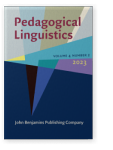Vol. 4:2 (2023) ► pp.159–194
Why are they so similar?
The interplay of linguistic and extra-linguistic variables in monolingual and bilingual learners of English
This study investigates the relationship between (extra)linguistic variables and proficiency in a foreign language. Based on 1,403 secondary school students in Germany (age 12/13 and 14/15), we assess whether proficiency in German, if applicable also Russian or Turkish, cognitive ability, school type, gender, socio-economic status, self-concept, motivation, and self-assessment function differently in predicting English language proficiency when monolingual German learners of English (n = 849) are compared to their bilingual peers (Russian-German: n = 236; Turkish-German: n = 318). Two comprehensive structural equation models capture the multitude of factors influencing foreign language acquisition and contribute to the discussion on multilingual advantages or effects. The results reveal that most variables are statistically significant, but the models function comparably across the three language groups with only minor contrasts regarding effect sizes. We submit that the three language groups are more similar than different and that the heritage languages Russian and Turkish add comparatively little to predicting English language proficiency.
Article outline
- 1.Introduction
- 2.Research questions
- 3.Methodology
- 3.1Participants
- 3.2The instruments
- 3.2.1English proficiency (response variable)
- 3.2.2Proficiency in the majority language German and the heritage languages Russian and Turkish
- 3.2.3Cognitive ability
- 3.2.4Socio-economic status
- 3.2.5Gender
- 3.2.6School type
- 3.2.7Age (year of birth)
- 3.2.8Attitudes (self-concept, motivation, self-assessment)
- 3.2.9Descriptive statistics
- 3.3Data analysis
- 4.Results
- 4.1Research question 1: Which linguistic and extra-linguistic variables add significantly to explaining the variance in English proficiency across bilingual and monolingual learners of English?
- 4.2Research question 2: How does heritage language proficiency contribute to explaining the variance in English proficiency of Russian-German and Turkish-German bilinguals?
- 5.Discussion
- 5.1Interdependence and language dominance
- 5.2Extra-linguistic variables override language effects
- 5.3Implications for the institutional environment
- 5.4Limitations
- 6.Conclusion
- Acknowledgements
- Notes
-
References
